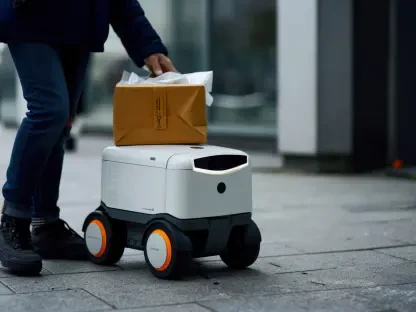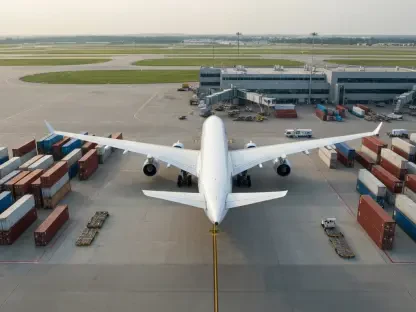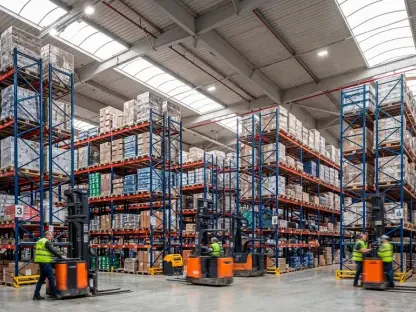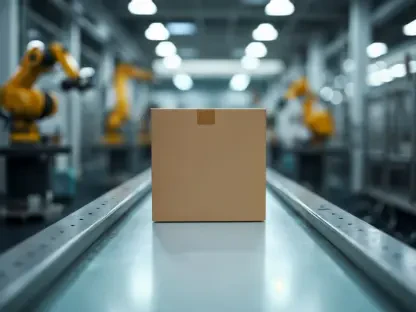Complex global supply chains aren’t polluting out of malicious intent. They pollute— repeatedly—due to a lack of integrated strategy and data coordination on sustainability. Every day, trucks run half-empty on return trips, warehouses blast heating or cooling even when inventory levels don’t demand it, and last-minute stockouts trigger air freight expedites.
The result? A carbon footprint that quietly balloons beyond targets, alongside mounting costs from wasted fuel and rushed shipments.
Industry studies are now putting numbers to these inefficiencies. Full truckload freight in the U.S. emits about 252 million metric tons of CO₂ annually, and a staggering 87 million of those tons come from trucks driving empty.
At the global level, logistics (freight transport and warehousing) produces roughly 10% of all emissions and is on track to increase by 42% by 2050, which would make it the single largest emitting sector if nothing changes.
For businesses, these inefficiencies don’t just harm the planet—they bleed money. A recent Accenture study found that bottlenecks and other supply chain snags lead to 20–30% in extra operating costs, costs often tied to things like idle equipment and expedited transit, which carry an emissions price tag as well.
Green logistics strategies can arrest these leaks.
This article unpacks how fragmented supply chain practices turn small inefficiencies into big carbon losses, why traditional siloed approaches can’t keep up, and how an integrated data-driven approach can transform sustainability efforts into efficiency and resilience. You’ll get a practical framework to kickstart logistics decarbonization in a way that preserves both the planet and your profit margins.
How Fragmentation Turns Small Gaps into Big Emissions
The fragmentation in supply chains is structural, not incidental. For decades, logistics data and processes lived in separate silos: procurement had its spreadsheets, carriers their own tracking systems, warehouses their local reports. Each stakeholder optimized for their piece—lowest unit cost, on-time delivery, etc.—often defending their own “source of truth” rather than sharing information freely.
In short, everyone is working from different versions of reality, a disconnect that fuels both operational hiccups and carbon inefficiency. It has long been warned that paper-heavy, non-standardized workflows leave partners misaligned and “working from different versions of reality,” leading to disputes, delays, and creeping costs in traditional supply chains.
Data silos at the enterprise level only compound the issue. One department tracks fuel usage in a fleet management system, another tracks supplier emissions in a procurement portal, and warehouse energy use lives in facilities management logs. None of these are reconciled in real time to steer decisions. It’s no surprise, then, that 72% of supply chain leaders say poor technology integration is a major barrier to transformation—data is gathered but not shared.
When systems don’t talk, inefficiencies flourish: inventory buffers bloat to hedge against unknowns, and transport runs underutilized because demand and capacity data never met.
Real-world volatility adds chaos. A sudden port closure or factory delay often isn’t visible to downstream carriers until trucks are already idling at a warehouse door. Telemetry data backs this up: trucks are driven empty 20–35% of all miles, and long-haul rigs idle around 1,800 hours per year, burning ~1,500 gallons of diesel per truck—much of that due to waiting or poor coordination.
Perhaps the most visible “scar tissue” of a fragmented supply chain is waste and rework.
Products get scrapped or rerouted due to shipping damage and delays that better data sharing could have prevented. In food logistics, nearly one-third of the food produced is lost across the supply chain. Delays alone forced 46% of surveyed shippers to discard entire loads, averaging 2.4 million pounds of wasted food per shipper per year.
That’s millions of meals—and all the fuel, water, and energy invested in them—literally trashed. Each failure of coordination carries a carbon cost: those discarded shipments equate to 20,000 gallons of diesel and 753 metric tons of greenhouse gases wasted per shipper annually.
Green Logistics Defined
Gather this: dumping data into a cloud drive or buying carbon offsets does not equal true coordination on sustainability. Greening the supply chain means structured, time-stamped, shareable information flowing across suppliers, carriers, warehouses, and customers—in a way that is both machine-readable for analysis and human-friendly for decision-making.
The good news is that the logistics industry is starting to move in this direction. Tools and standards are emerging to break down the data silos. The Global Logistics Emissions Council framework now underpins ISO 14083 for logistics carbon accounting, so a carrier in Spain and a shipper in South Africa can finally speak the same language on CO₂ per ton-kilometer.
Likewise, major platforms are opening up: digital freight networks like Convoy use cloud platforms to coordinate truck loads and have launched #NoEmptyMiles campaigns to share capacity data, a collaboration approach that can cut empty trips and associated emissions. Meanwhile, Internet of Things sensors now monitor everything from truck engine performance to warehouse energy consumption, and advanced analytics platforms can bulk-extract this cross-functional data into business intelligence tools.
But the issue isn’t just where the data lives; it’s whether it flows. True coordination means these systems talk to each other. An electric truck’s telematics should feed into the route planning system to adjust for charging needs; the procurement software should sync with suppliers’ sustainability data so that order decisions factor in carbon intensity; the warehouse management system should be tied into real-time energy prices to schedule energy-intensive work at low-carbon grid times.
Greening the supply chain is fundamentally a data integration challenge: one that turns disjointed bits of information into a holistic view of where your emissions are and how to reduce them. It’s not as simple as buying a few electric trucks or planting trees to offset emissions.
Yet that’s exactly where the strategic leverage lies, as you’ll explore next.
The Business Case
Making supply chains low-carbon is about building a better business. Coordination and data-driven sustainability efforts directly translate to risk reduction, cost control, and faster, smarter decisions. In fact, a well-executed green logistics strategy essentially becomes a financial buffer in an uncertain world. Here’s how and why:
Waste & Rework Avoidance: Better coordination means fewer mistakes and less waste. By connecting the dots—for example, linking real-time inventory levels and sales forecasts with production and shipping plans—companies can prevent excess orders or rush shipments that lead to gluts and spoilage. The food industry example makes it plain: freight inefficiencies (like misrouted or delayed loads) are a leading cause of waste in food and beverage supply chains.
Efficiency Gains & Cost Savings: Numerous studies have found that digitizing and integrating supply chain data yields significant productivity improvements. When teams collaborate using accurate, up-to-date information (for instance, sharing a live digital twin of the supply chain), they tend to make better decisions that cut costs. Companies with technologically mature, well-integrated supply chains are 23% more profitable on average.
Asset & Capacity Utilization: A coordinated approach helps reduce underutilization of empty trucks, half-full containers, and idle inventory. The impact is huge: in the U.S. alone, 87 million tons of CO₂ each year are attributed to trucks running empty. Cutting empty miles through better load matching or collaborative shipping means shippers pay for what they use, which improves margins—and you avoid emitting carbon for zero gain.
Predictive Risk Management & Resilience: Perhaps one of the most underappreciated benefits of integrating data is the ability to see problems coming—and act before they become costly (and carbon-intensive) emergencies. Unified analytics platforms are now delivering early warning signals across supply, demand, and transit. For example, AI-driven “control towers” can flag a supplier delay or port congestion weeks in advance, prompting a shift to an alternate source or route before you’re forced into an expensive workaround (like last-minute air freight, which carries a massive carbon footprint). By preventing schedule slippage and stockouts, companies avoid the cascade of expedited shipping, overtime, and safety stock that typically follows – all of which drive up emissions and costs. In short, a coordinated, data-rich supply chain is a resilient supply chain.
And here’s the kicker: even with the best tools, you won’t reap these rewards if you lack the right data governance and strategy. Many firms buy into visibility software or sustainability dashboards, but then fail to standardize data or processes across teams, limiting the impact. As one analysis noted, sloppy integration—incompatible data formats, duplicate entries, missing data ownership—leads to fragmented insights and undermines improvement efforts; it’s a big reason why only 30% of digital transformation efforts succeed.
To turn information into foresight (and profit), organizations need executive-level commitment to coordination. Without that governance, even the fanciest sustainability software will gather dust while teams fall back to familiar habits.
How to Start: The Low-Carbon Logistics Playbook
For companies ready to stop the bleeding of both carbon and cash, supply chain coordination is a frontline business strategy. How to operationalize it? Here’s a practical step-by-step playbook:
Define Your “Carbon Profit & Risk” Baseline: Quantify where emissions are concentrated and how inefficiencies are costing you. Make it visible in hard numbers.
Map Critical Flows and Data Hand-offs: Identify where data silos exist and where decisions are being made with partial information.
Establish a Common Data Environment (with Open Pipes): Implement a platform with open APIs where all stakeholders can feed data into one source of truth.
Embed Environmental Metrics into Planning Early: Don’t bolt on sustainability at the end; integrate it at the design and planning phase. Also, integrate emissions data into network modeling, supplier selection, and routing decisions.
Integrate IoT Telemetry for Real-Time Insights: Data coordination isn’t static; it’s most powerful in real time. Use sensors and smart meters to capture live operations data that informs adjustments.
Standardize Data and Processes with Partners: A coordinated, low-carbon supply chain isn’t achieved in isolation; it’s a team sport with your suppliers, carriers, 3PLs, and even customers. Share sustainability protocols and require structured data formats.
Push Actionable Dashboards to the Front Line: To sustain momentum, the data can’t just live with analysts or in quarterly reports; it needs to deliver value on the ground in real time. Provide live tools and metrics to operational teams so they can make greener decisions daily.
Close the Loop with Predictive Analytics and Alerts: Once you have data streaming and a culture of using it, take the next step: forecast and preempt instead of just react and suggest lower-carbon responses early.
Together, these practices ensure your operations stay lean and green, and that you meet your targets instead of scrambling after the fact.
No, Your Supply Chain Isn’t “Green Enough” — But It Can Be
Like a burned-out employee claiming “I’m fine” when nothing is fine, many companies reassure themselves that their supply chain sustainability is “under control” – often because a few metrics are reported, or a recycling program is in place, or they’ve bought carbon offsets. The hard truth is usually different. Which system is that data in? How current is it? Who actually trusts it? Too often, emissions data is months old and lives in a standalone report, disconnected from daily operations.
In logistics as in construction, the cost of fragmentation and half-measures is very real— measured in lost hours, wasted fuel, excess inventory, rework and recalls, claim disputes, and diluted margins. The status quo quietly erodes both profit and planetary health, one small inefficiency at a time.
So, no, your project data or logistics data is probably not “fine” if it lives in silos and only tells you yesterday’s news. But it can be fine, even great, if you commit to breaking down the walls and investing in coordination.
The opportunity is on the table; it’s time to seize it.









